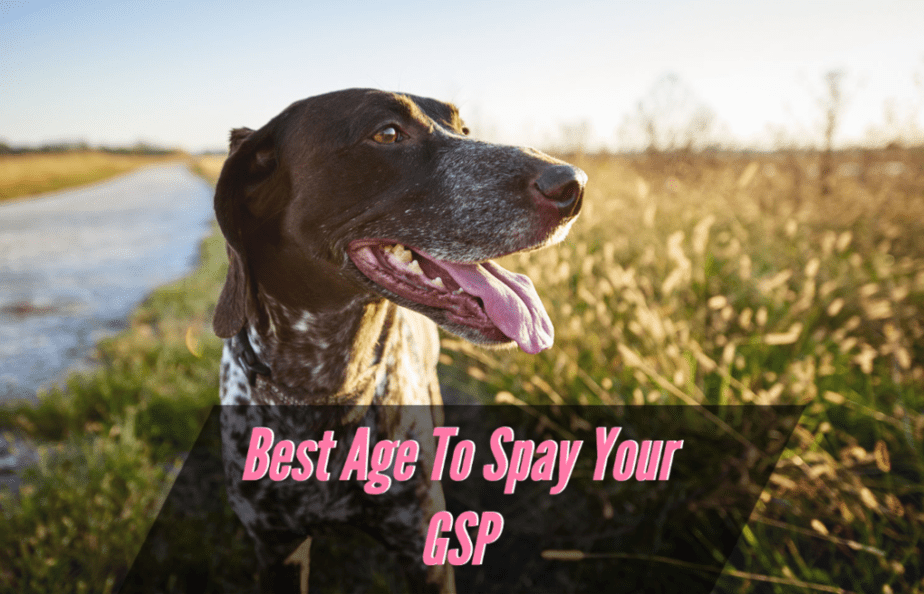The German Shorthaired Pointer (GSP) is one of the most loving and family-friendly dog breeds out there. This breed doesn’t necessitate a lot of attention.
Yet, there comes a time when you as the dog owner simply don’t want any more GSP puppies.
If you have a female dog, spaying is unquestionably the best option. However, you need to spay the dog at the appropriate age.
In this post, we’ll shed light on the best age to spay a German Shorthaired Pointer as well as the benefits that come with spaying your furry friend.
Let’s jump right into it!

When Should You Spay a GSP?
You can spay your GSP around the ages of four and nine months.
However, it’s recommended that you spay your German Shorthaired Pointer after she has reached maturity.
Some people also advise spaying before your dog’s first heat. It’s thought that it helps reduce the risk of mammary cancer if you spay your dog before the heat cycle.
Spaying early also makes the operation safer. It reduces the risk of problems like bleeding and discomfort.
Difference Between Spaying and Neutering
The purpose of both neutering and spaying is one. They both remove the reproductive systems so the dog won’t be able to breed. However, there are some distinctions between spaying and neutering.
Neutering
Neutering refers to the removal of the testicles in a male dog. As a result, the dog will no longer be able to breed.
In most cases, a dog’s interest in mating will fade. The entire treatment takes only a few minutes and will only take a few days to heal.
Spaying
Spaying is the removal of the uterus and ovaries of a female dog. It’s accomplished through anesthesia-assisted surgery.
The veterinarian enters the abdominal cavity and ties off the blood flow in many areas of the body.
Spayed dogs, like neutered dogs, will need to rest. However, the procedure is much more complicated.
As a result, females take longer to recover than male canines. Females should rest for two to four weeks after a spaying surgery.
When Do Dogs Start Heat?
When German Shorthaired Pointers are five to fourteen months old, they will experience their first heat cycle.
After the first cycle, the next will begin six months later and last for the rest of the dog’s lifetime. The initial heat cycle occurs earlier in smaller dogs.
Every six months or so, the dogs go into heat. Each heat lasts about 16-18 days on average.
There are many telltale signs to know when your dog is entering the heat cycle. Some of these symptoms are:
- A swollen vulva
- Brown, yellow, or red discharge
- Licking the back end more than usual
- Urinating more than the usual
Additionally, there are behavioral changes such as:
- Wandering alone to find other dogs
- Humping
- Changes the tail’s position
- Becoming anxious
What Happens If a Dog Is Spayed Early?
The hormone imbalance will be affected by spaying or neutering your dog.
Because the procedure gets rid of the reproductive organs, the body’s hormone levels drop. That can cause several complications with your dog as she grows.
Some of the complications that you need to keep in mind:
Risk of Gaining Weight
Spayed dogs will gain a lot of weight if they eat the same quantity of food they ate before they were spayed.
Your dog’s metabolism and desire to eat will change after spaying. As a result, this will leave her more inclined to gain weight.
Excess weight puts your dog at risk for diseases and shortens her lifespan. Arthritis, heart disease, and cancer are all potential risks of weight gain.
Risk of Hip Dysplasia
Hip dysplasia is a skeletal condition that impairs dogs as they mature. This condition results in hip joint weakness, as the joints don’t align or grow normally.
Instead of gliding softly, the joints scrape and cause friction. This causes the joint to weaken over time and eventually lose its usefulness.
The most common symptoms are weakness and soreness in the back legs.
The dog is usually unsteady and unwilling to stand up from a seated or resting position. Some dogs will stumble up the steps or be hesitant to walk on the stairs.
Behavioral Problems
Spaying a dog can result in a behavioral change. Fearful behavior and strong reactions to stressful situations are common.
They can withdraw from people or places they don’t know. Additionally, dogs can have a strong emotional reaction to loud noises like fireworks.
Although most dogs don’t display this behavior, some become more aggressive.
Lack of Growth Hormones
Growth hormones are among the hormones that are affected. Growth hormone deficiency can harm the dog’s bones and possibly cause hair loss.
Affected dogs may become limp and unwilling to move around. These indications may appear and disappear. Your veterinarian may recommend growth hormone injections.
Why Should You Spay Your Dog?
Spaying female dogs is advised as it’s good for your dog’s health. Spaying your dog has many advantages and perks, including:
Reduces Aggressive Behavior
Females who have not been spayed strive for a male dog’s interest by sparring. After your dog has done the surgery, aggressive behaviors will be reduced and your dog will be less hostile.
Prevents Pyometra
Pyometra is an infection that develops as a result of hormonal fluctuations. It’s a womb infection that could be fatal.
The hormone progesterone levels are high for up to two months after the dog goes into heat. This leads to the thickening of the uterine lining in readiness for pregnancy.
Some of the symptoms include:
- Red vaginal discharge
- Vomiting
- Appetite loss
- Abdomen that is swollen or uncomfortable
Prevents Mammary Tumors
A mammary tumor is a tumor that affects the mammary gland in the breast. They could be malignant or not, and the latter is becoming more likely. One or more detectable lumps beneath the skin of the abdomen are the most prevalent symptom.
In dogs, progesterone raises the risk of getting mammary cancer. So, when a dog is spayed, the hormone production drops. The drop minimizes the chances of mammary cancer.
Prevents Phantom Pregnancies
A phantom pregnancy, also known as a false pregnancy, is common in female dogs as well as humans.
Phantom pregnancy is when a dog exhibits maternal behaviors without actually being pregnant. Additionally, it shows physical symptoms of pregnancy.
In dogs, phantom pregnancies can lead to sadness and a loss of appetite. Some of the canines who are impacted will display symptoms of fake labor.
Since spaying removes the reproductive organs of the dog, phantom pregnancies will not occur.
Wrapping Up
The best age to spay your GSP is around four and nine months old. However, you should wait until your dog has reached adolescence and before her first heat cycle before doing so.
Make sure you don’t spay your dog too early, as this can put your dog’s health at risk.
German shorthaired pointers usually attain sexual maturity between the ages of five and fourteen months.
A swelling vulva and a brown discharge are two symptoms that indicate the start of the heat cycle.
Spaying dogs has many advantages, including tumor prevention and less aggressive behavior.
So after spaying, you’ll have a happy and healthy dog.

